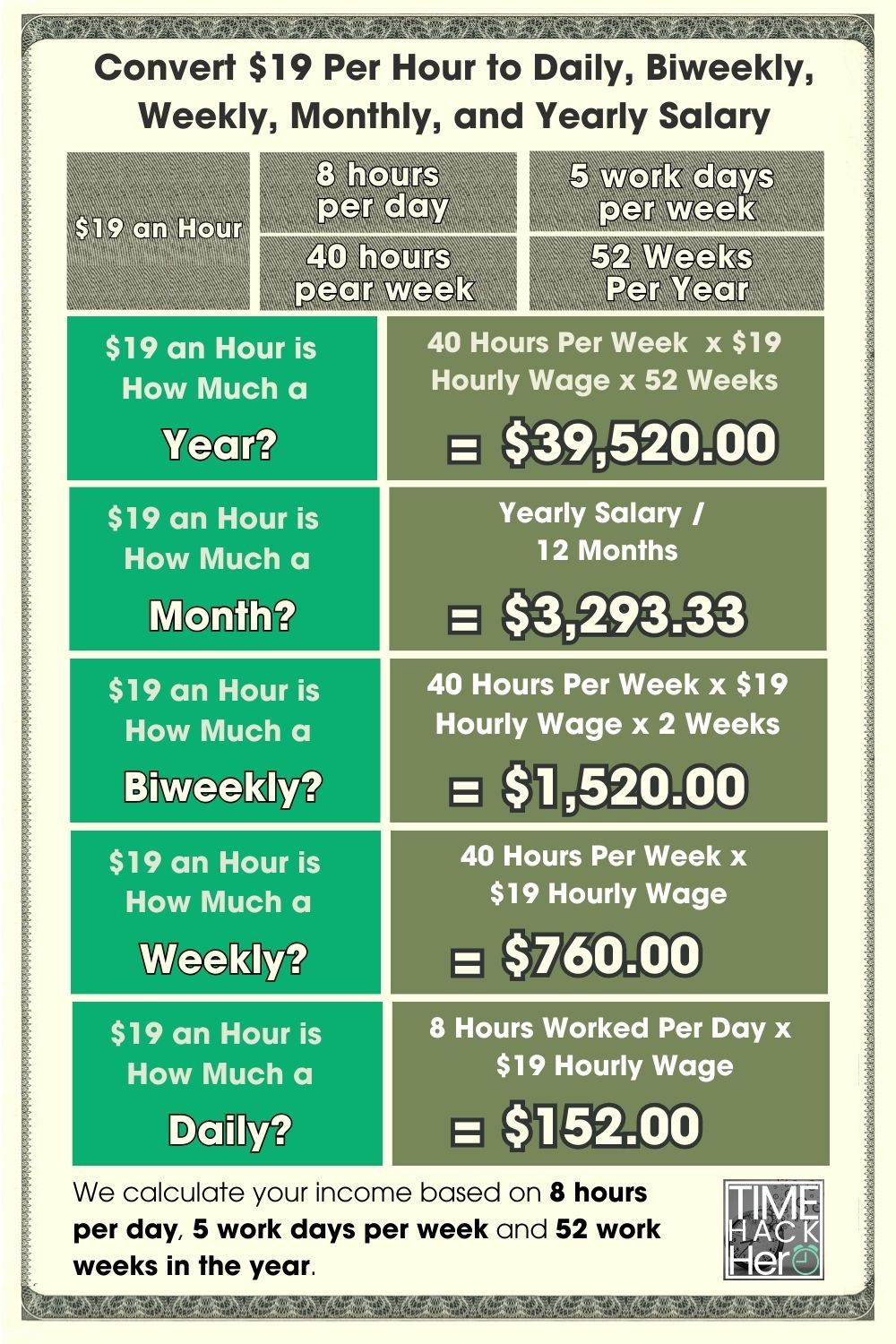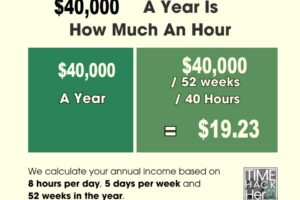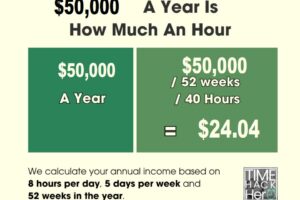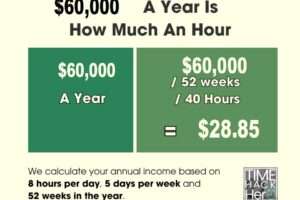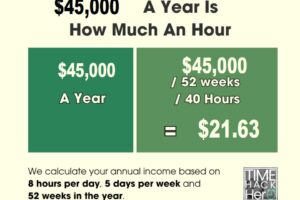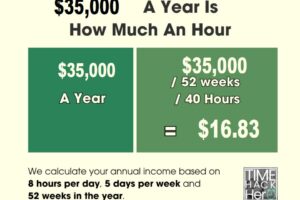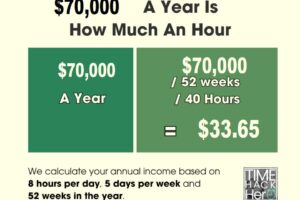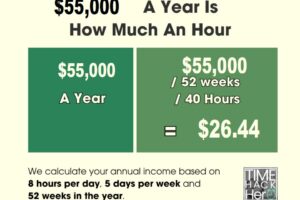In today’s economy, many workers are focused on boosting their hourly wages to keep up with the rising cost of living. For those earning $19 an hour, what kind of annual salary can this hourly rate provide? Converting an hourly wage to a yearly salary is crucial for understanding your true earning potential.
This article will break down the annual, monthly, biweekly, and weekly salaries that come out to $19 per hour. We’ll look at how factors like overtime, part-time work, and unpaid time off can impact total earnings in a year at this pay rate. Additionally, we’ll discuss whether $19 an hour is considered a good salary nowadays and what kind of lifestyle it can afford.
To provide a complete overview, we’ll also calculate the annual salary you’d take home after tax deductions on $19 an hour. You’ll find out how elements like federal, state, and local taxes impact your net pay. Whether you currently make $19 an hour or aspire to in the future, this article will give you a clear picture of how far that wage goes on a yearly basis.
Table of Contents
Convert $19 Per Hour to Weekly, Monthly, and Yearly Salary
Input your wage and hours per week to see how much you’ll make monthly, yearly and more.
$19 an Hour is How Much a Year?
If you make $19 an hour, your yearly salary would be $39,520. We calculate your annual income based on 8 hours per day, 5 days per week and 52 weeks in the year.
Hours worked per week (40) x Hourly wage($19) x Weeks worked per year(52) = $39,520
$19 an Hour is How Much a Month?
If you make $19 an hour, your monthly salary would be $3,293.33. We calculated this number by dividing your annual income by 12 months.
Hours worked per week (40) x Hourly wage($19) x Weeks worked per year(52) / Months per Year(12) = $3,293.33
$19 an Hour is How Much a Biweekly?
If you make $19 an hour, your biweekly salary would be $1,520.
Hours worked per week (40) x Hourly wage($19) x 2 = $1,520
$19 an Hour is How Much a Week?
If you make $19 an hour, your weekly salary would be $760. Calculating based on 5 days per week and 8 hours each day.
Hours worked per week (40) x Hourly wage($19) = $760
$19 an Hour is How Much a Day?
If you make $19 an hour, your daily salary would be $152. We calculated your daily income based on 8 hours per day.
Hours worked per day (8) x Hourly wage($19) = $152
$19 an Hour is How Much a Year?
The basic formula to calculate your annual salary from an hourly wage is:
Hourly Rate x Hours Worked per Week x Number of Weeks Worked per Year = Annual Salary
So for a $20 per hour job:
$19 per hour x 40 hours per week x 52 weeks per year = $39,520
However, this simple calculation makes some assumptions:
- You will work 40 hours every week of the year
- You will not get any paid time off
Therefore, it represents your earnings if you worked every week of the year, without any vacation, holidays, or sick days.
Accounting for Paid Time Off
The $39,520 base salary does not yet factor in paid time off (PTO). Let’s assume the job provides:
- 2 weeks (10 days) paid vacation
- 6 paid holidays
- 3 paid sick days
This totals 19 paid days off, or nearly 4 weeks of PTO.
Importantly, this paid time off should not be deducted from the annual salary, since you still get paid for those days.
So with 4 weeks PTO, the annual salary would remain $39,520 .
Part time $19 an hour is How Much a Year?
Your annual income changes significantly if you work part-time and not full-time.
For example, let’s say you work 20 hours per week instead of 40. Here’s how you calculate your new yearly total:
$19 per hour x 20 hours per week x 52 weeks per year = $19,760
By working 20 fewer hours per week (20 instead of 40), your annual earnings at $19 an hour drop from $39,520 to $19,760.
That’s a $19,760 per year difference just by working part-time!
Here’s a table summarizing how your annual earnings change depending on how many hours you work per week at $19 an hour:
| Hours Per Week | Earnings Per Week | Annual Earnings |
|---|---|---|
| 40 | $760 | $39,520 |
| 35 | $665 | $34,580 |
| 30 | $570 | $29,640 |
| 25 | $475 | $24,700 |
| 20 | $380 | $19,760 |
| 15 | $285 | $14,820 |
The more hours per week, the higher your total yearly earnings. But part-time work allows for more life balance if you don’t need the full salary.
$19 an Hour With Overtime is How Much a Year?
Now let’s look at how overtime can increase your annual earnings.
Overtime kicks in once you work more than 40 hours in a week. Typically, you earn 1.5x your regular hourly wage for overtime hours.
So if you make $19 per hour normally, you would make $28.50 per hour for any hours over 40 in a week.
Here’s an example:
- You work 45 hours in a Week
- 40 regular hours paid at $19 per hour = $760
- 5 overtime hours paid at $28.50 per hour = $142.50
- Your total one Week earnings =$760 + $142.50 = $902.50
If you worked 45 hours each week for 52 weeks, here’s how your annual earnings increase thanks to overtime pay:
$902.50 per week x 52 weeks per year = $46,930
That’s $7,410 more than you’d earn working just 40 hours per week at $19 an hour.
Overtime can add up! But also consider taxes and work-life balance when deciding on extra hours.
Here’s a table summarizing how your annual earnings change depending on how many hours you work per week at $19 an hour:
| Overtime hours per work day | Hours Per Week | Earnings Per Week | Annual Earnings |
| 0 | 40 | $760 | $39,520 |
| 1 | 45 | $902.50 | $46,930 |
| 2 | 50 | $1,045 | $54,340 |
| 3 | 55 | $1,187.50 | $61,750 |
| 4 | 60 | $1,330 | $69,160 |
| 5 | 65 | $1,472.50 | $76,570 |
| 6 | 70 | $1,615 | $83,980 |
| 7 | 75 | $1,757.50 | $91,390 |
How Unpaid Time Off Impacts $19/Hour Yearly Earnings
So far we’ve assumed you work 52 paid weeks per year. Any unpaid time off will reduce your total income.
For example, let’s say you take 2 weeks of unpaid leave. That brings your paid weeks down to 50:
Hours worked per week (40) x Hourly wage($19) x Weeks worked per year(50) = $38,000 annual salary
With 2 weeks unpaid time off, your annual earnings at $19/hour would drop by $1,520.
The table below summarizes how your annual income changes depending on the number of weeks of unpaid leave.
| Weeks of unpaid leave | Paid weeks per year | Earnings Per Week | Annual Earnings |
| 0 | 52 | $760 | $39,520 |
| 1 | 51 | $760 | $38,760 |
| 2 | 50 | $760 | $38,000 |
| 3 | 49 | $760 | $37,240 |
| 4 | 48 | $760 | $36,480 |
| 5 | 47 | $760 | $35,720 |
| 6 | 46 | $760 | $34,960 |
| 7 | 45 | $760 | $34,200 |
Key Takeaways for $19 Hourly Wage
In summary, here are some key points on annual earnings when making $19 per hour:
- At 40 hours per week, you’ll earn $39,520 per year.
- Part-time of 30 hours/week results in $29,640 annual salary.
- Overtime pay can boost yearly earnings, e.g. $7,410 extra at 45 hours/week.
- Unpaid time off reduces your total income, around $1,520 less per 2 weeks off.
- Your specific situation and location impacts taxes and PTO.
Knowing your approximate annual salary and factors impacting it makes it easier to budget and plan your finances. The next step is calculating take-home pay after deductions like taxes.
$19 An Hour Is How Much A Year After Taxes
Figuring out your actual annual earnings based on an hourly wage can be complicated once taxes are taken into account. In addition to federal, state, and local income taxes, 7.65% of your gross pay also goes to Social Security and Medicare through FICA payroll taxes. So how much does $19 an hour equal per year after FICA and income taxes are deducted from your gross pay?
Below we’ll walk through the steps to calculate your annual net take home pay if you make $19 per hour. This will factor in estimated federal, FICA, state, and local taxes so you know exactly what to expect.
Factoring in Federal Income Tax
Your federal income tax will be a big chunk out of your gross pay. Federal tax rates range from 10% to 37%, depending on your tax bracket.
To estimate your federal income tax rate and liability:
Look up your federal income tax bracket based on your gross pay.
2023 tax brackets: single filers
| Tax rate | Taxable income bracket | Tax owed |
|---|---|---|
| 10% | $0 to $11,000. | 10% of taxable income. |
| 12% | $11,001 to $44,725. | $1,100 plus 12% of the amount over $11,000. |
| 22% | $44,726 to $95,375. | $5,147 plus 22% of the amount over $44,725. |
| 24% | $95,376 to $182,100. | $16,290 plus 24% of the amount over $95,375. |
| 32% | $182,101 to $231,250. | $37,104 plus 32% of the amount over $182,100. |
| 35% | $231,251 to $578,125. | $52,832 plus 35% of the amount over $231,250. |
| 37% | $578,126 or more. | $174,238.25 plus 37% of the amount over $578,125. |
For example, if you are single with $39,520 gross annual pay, your federal tax bracket is 12%.
Your estimated federal tax would be:
$1,100 + ($39,520 – $11,000) x 12% = $4,522.40
So at $19/hour with $39,520 gross pay, you would owe about $4,522.40 in federal income taxes.
Considering State Income Tax
In addition to federal tax, most states also charge a state income tax. State income tax rates range from about 1% to 13%, with most falling between 4% and 6%.
Key Takeaways
-
- California, Hawaii, New York, New Jersey, and Oregon have some of the highest state income tax rates.
- Alaska, Florida, Nevada, South Dakota, Tennessee, Texas, Washington, and Wyoming don’t impose an income tax at all.
- Another 10 U.S states have a flat tax rate—everyone pays the same percentage regardless of how much they earn.
A State-by-State Comparison of Income Tax Rates
| STATE | TAX RATES | LOWEST AND HIGHEST INCOME BRACKETS |
|---|---|---|
| Alaska | 0% | None |
| Florida | 0% | None |
| Nevada | 0% | None |
| South Dakota | 0% | None |
| Tennessee | 0% | None |
| Texas | 0% | None |
| Washington | 0% | None |
| Wyoming | 0% | None |
| Colorado | 4.55% | Flat rate applies to all incomes |
| Illinois | 4.95% | Flat rate applies to all incomes |
| Indiana | 3.23% | Flat rate applies to all incomes |
| Kentucky | 5% | Flat rate applies to all incomes |
| Massachusetts | 5% | Flat rate applies to all incomes |
| New Hampshire | 5% | Flat rate on interest and dividend income only |
| North Carolina | 4.99% | Flat rate applies to all incomes |
| Pennsylvania | 3.07% | Flat rate applies to all incomes |
| Utah | 4.95% | Flat rate applies to all incomes |
| Michigan | 4.25% | Flat rate applies to all incomes |
| Arizona | 2.59% to 4.5% | $27,806 and $166,843 |
| Arkansas | 2% to 5.5% | $4,300 and $8,501 |
| California | 1% to 13.3% | $9,325 and $1 million |
| Connecticut | 3% to 6.99% | $10,000 and $500,000 |
| Delaware | 0% to 6.6% | $2,000 and $60,001 |
| Alabama | 2% to 5% | $500 and $3,001 |
| Georgia | 1% to 5.75% | $750 and $7,001 |
| Hawaii | 1.4% to 11% | $2,400 and $200,000 |
| Idaho | 1.125% to 6.5% | $1,568 and $7,939 |
| Iowa | 0.33% to 8.53% | $1,743 and $78,435 |
| Kansas | 3.1% to 5.7% | $15,000 and $30,000 |
| Louisiana | 1.85% to 4.25% | $12,500 and $50,001 |
| Maine | 5.8% to 7.15% | $23,000 and $54,450 |
| Maryland | 2% to 5.75% | $1,000 and $250,000 |
| Minnesota | 5.35% to 9.85% | $28,080 and $171,221 |
| Mississippi | 0% to 5% | $5,000 and $10,001 |
| Missouri | 1.5% to 5.3% | $1,121 and $8,968 |
| Montana | 1% to 6.75% | $2,900and $17,400 |
| Nebraska | 2.46% to 6.84% | $3,340 and $32,210 |
| New Jersey | 1.4% to 10.75% | $20,000 and $1 million |
| New Mexico | 1.7% to 5.9% | $5,500 and $210,000 |
| New York | 4% to 10.9% | $8,500 and $25 million |
| North Dakota | 1.1% to 2.9% | $41,775 and $458,350 |
| Ohio | 0% to 3.99% | $25,000 and $110,650 |
| Oklahoma | 0.25% to 4.75% | $1,000 and $7,200 |
| Oregon | 4.75% to 9.9% | $3,750 and $125,000 |
| Rhode Island | 3.75% to 5.99% | $68,200 and $155,050 |
| South Carolina | 0% to 7% | $3,110 and $15,560 |
| Vermont | 3.35% to 8.75% | $42,150 and $213,150 |
| Virginia | 2% to 5.75% | $3,000 and $17,001 |
| Washington, D.C. | 4% to 9.75% | $10,000 and $1 million |
| West Virginia | 3% to 6.5% | $10,000 and $60,000 |
| Wisconsin | 3.54% to 7.65% | $12,760 and $280,950 |
To estimate your state income tax:
Look up your state income tax rate based on your gross pay and filing status.
Multiply your gross annual pay by the state tax rate.
For example, if you live in Pennsylvania which has a flat 3.07% tax rate, your estimated state tax would be:
$39,520 gross pay x 3.07% PA tax rate = $1,213.26 estimated state income tax
So with $39,520 gross annual income, you would owe around in $1,213.26 Pennsylvania state income tax. Verify your specific state’s income tax rates.
Factoring in Local Taxes
Some cities and counties levy local income taxes ranging from 1-3% of taxable income.
To estimate potential local taxes you may owe:
- Check if your city or county charges a local income tax.
- If yes, look up the local income tax rate.
- Multiply your gross annual pay by the local tax rate.
For example, say you live in Columbus, OH which has a 2.5% local income tax. Your estimated local tax would be:
$39,520 gross pay x 2.5% local tax rate = $988 estimated local tax
So with $39,520 in gross earnings, you may owe around $988 in Columbus local income taxes. Verify rates for your own city/county.
Accounting for FICA Taxes (Social Security & Medicare)
FICA taxes are a combination of Social Security and Medicare taxes that equal 15.3% of your earnings. You are responsible for half of the total bill (7.65%), which includes a 6.2% Social Security tax and 1.45% Medicare tax on your earnings.
In 2023, only the first $160,200 of your earnings are subject to the Social Security tax
There is an additional 0.9% surtax on top of the standard 1.45% Medicare tax for those who earn over $200,000 (single filers) or $250,000 (joint filers).
To estimate your FICA tax payment:
$39,520 x 6.2% + $39,520 x 1.45% = $3,023.28
So you can expect to pay about $3,023.28 in Social Security and Medicare taxes out of your gross $39,520 in earnings.
Total Estimated Tax Payments
Based on the examples above, your total estimated tax payments would be:
Federal tax: $4,522.40
State tax: $1,213.26
Local tax: $988
FICA tax: $3,023.28
Total Estimated Tax: $9,746.94
Calculating Your Take Home Pay
To calculate your annual take home pay at $19 /hour:
1. Take your gross pay
2. Subtract your estimated total tax payments
$39,520 gross pay – $9,746.94 Total Estimated Tax = $29,773.06 Your Take Home Pay
n summary, if you make $19 per hour and work full-time, you would take home around $29,773.06 per year after federal, state, local , FICA taxes.
Your actual net income may vary depending on your specific tax situation. But this gives you a general idea of what to expect.
Convert $19 Per Hour to Yearly, Monthly, Biweekly, and Weekly Salary After Taxes
If you make $19 an hour and work full-time (40 hours per week), your estimated yearly salary would be $39,520 .
The $39,520 per year salary does not account for taxes. Federal, state, and local taxes will reduce your take-home pay. The amount withheld depends on your location, filing status, dependents, and other factors.
Just now during our calculation of $19 An Hour Is How Much A Year After Taxes, we assumed the following conditions:
- You are single with $39,520 gross annual pay, your federal tax bracket is 12 %.
- You live in Pennsylvania which has a flat 3.07% tax rate
- You live in Columbus, OH which has a 2.5% local income tax.
In the end, we calculated your Total Estimated Tax is $9,746.94 , Your Take Home Pay is $29,773.06 , Total tax rate is 24.66%.
So next we’ll use 24.66% as the estimated tax rate to calculate your weekly, biweekly, and monthly after-tax income.
$19 Per Hour to Yearly, Monthly, Biweekly, Weekly,and Week Salary After Taxes Table
| Income before taxes | Estimated Tax Rate | Income Taxes | After Tax Income | |
| Yearly Salary | $39,520 | 24.66% | $9,746.94 | $29,773.06 |
| Monthly Salary | $3,293.33 | 24.66% | $812.25 | $2,481.09 |
| BiWeekly Salary | $1,520 | 24.66% | $374.88 | $1,145.12 |
| Weekly Salary | $760 | 24.66% | $187.44 | $572.56 |
$19 an hour is how much a year after taxes
Here is the adjusted yearly salary after a 24.66% tax reduction:
-
- Yearly salary before taxes: $39,520
- Estimated tax rate: 24.66%
- Taxes owed (24.66% * $39,520 )= $9,746.94
- Yearly salary after taxes: $29,773.06
| Hourly Wage | Hours Worked Per Week | Weeks Worked Per Year | Total Yearly Salary | Estimated Tax Rate | Taxes Owed | After-Tax Yearly Salary |
|---|---|---|---|---|---|---|
| $19 | 40 | 52 | $39,520 | 24.66% | $9,746.94 | $29,773.06 |
$19 an hour is how much a month after taxes
To calculate the monthly salary based on an hourly wage, you first need the yearly salary amount. Then divide by 12 months.
-
-
- Yearly salary before taxes at $19 per hour: $39,520
- Divided by 12 months per year: $39,520 / 12 = $3,293.33 per month
-
The monthly salary based on a 40 hour work week at $19 per hour is $3,293.33 before taxes.
After applying the estimated 24.66% tax rate, the monthly after-tax salary would be:
-
- Monthly before-tax salary: $3,293.33
- Estimated tax rate: 24.66%
- Taxes owed (24.66% * $3,293.33 )= $812.25
- Monthly after-tax salary: $2,481.09
Monthly Salary Based on $19 Per Hour
| Hourly Wage | Yearly Salary | Months Per Year | Before-Tax Monthly Salary | Estimated Tax Rate | Taxes Owed | After-Tax Monthly Salary |
|---|---|---|---|---|---|---|
| $19 | $39,520 | 12 | $3,293.33 | 24.66% | $812.25 | $2,481.09 |
$19 an hour is how much biweekly after taxes
Many people are paid biweekly, meaning every other week. To calculate the biweekly pay at $19 per hour:
- Hourly wage: $19
- Hours worked per week: 40
- Weeks per biweekly pay period: 2
- $19 * 40 hours * 2 weeks = $1,520 biweekly
Applying the 24.66%estimated tax rate:
- Biweekly before-tax salary: $1,520
- Estimated tax rate: 24.66%
- Taxes owed (24.66% * $1,520 )= $374.88
- Biweekly after-tax salary: $1,145.12
Biweekly Salary at $19 Per Hour
| Hourly Wage | Hours Worked Per Week | Weeks Per Pay Period | Before-Tax Biweekly Salary | Estimated Tax Rate | Taxes Owed | After-Tax Biweekly Salary |
|---|---|---|---|---|---|---|
| $19 | 40 | 2 | $1,520 | 24.66% | $374.88 | $1,145.12 |
$19 an hour is how much weekly after taxes
To find the weekly salary based on an hourly wage, you need to know the number of hours worked per week. At 40 hours per week, the calculation is:
- Hourly wage: $19
- Hours worked per week: 40
- $19 * 40 hours = $760 per week
Accounting for the estimated 24.66% tax rate:
- Weekly before-tax salary: $760
- Estimated tax rate: 24.66%
- Taxes owed (24.66% * $760 )= $187.44
- Weekly after-tax salary: $572.56
Weekly Salary at $19 Per Hour
| Hourly Wage | Hours Worked Per Week | Before-Tax Weekly Salary | Estimated Tax Rate | Taxes Owed | After-Tax Weekly Salary |
|---|---|---|---|---|---|
| $19 | 40 | $760 | 24.66% | $187.44 | $572.56 |
Key Takeaways
- An hourly wage of $19 per hour equals a yearly salary of $39,520 before taxes, assuming a 40 hour work week.
- After accounting for an estimated 24.66% tax rate, the yearly after-tax salary is approximately $29,773.06 .
- On a monthly basis before taxes, $19 per hour equals $3,293.33 per month. After estimated taxes, the monthly take-home pay is about $2,481.09 .
- The before-tax weekly salary at $19 per hour is $760 . After taxes, the weekly take-home pay is approximately $572.56 .
- For biweekly pay, the pre-tax salary at $19 per hour is $1,520 . After estimated taxes, the biweekly take-home pay is around $1,145.12 .
Understanding annual, monthly, weekly, and biweekly salary equivalents based on an hourly wage is useful when budgeting and financial planning. Taxes make a significant difference in take-home pay, so be sure to account for them when making income conversions. Use this guide as a reference when making salary calculations.
What Is the Average Hourly Wage in the US?
Last Updated: Sep 1 2023
US Average Hourly Earnings is at a current level of $33.82, up from 33.74 last month and up from 32.43 one year ago. This is a change of 0.24% from last month and 4.29% from one year ago.
Average Hourly Earnings is the average dollars that a private employee makes per hour in the US. This metric is a part of one of the most important releases every month which includes unemployment numbers as well. This is normally released on the first Friday of every month. This metric is released by the Bureau of Labor Statistics (BLS).
What is the average salary in the U.S.?
Last Updated: July 18, 2023
The U.S. Bureau of Labor Statistics uses median salary data rather than averages to avoid skewed numbers from outlying high and low numbers. Median weekly earnings of the nation's 121.5 million full-time wage and salary workers were $1,100 in the second quarter of 2023, the U.S.
If a person works 52 weeks in the year, then this represents a national annual salary of $57,200.
Is $19 an Hour a Good Salary?
Whether $19 per hour is considered a good wage largely depends on where you live and your household size. The federal minimum wage is currently $7.25, so $19 is well above that baseline. However, according to data from the Economic Policy Institute, a single adult without children needs to earn $23.96 per hour for a modest but adequate living standard in the average U.S. community. For a family of four with two children, this “living wage” threshold jumps to $53.30.
Clearly, a salary of $19 per hour does not provide a lavish lifestyle for households with high expenses. However, it may be sufficient for single adults or dual income couples without children in lower cost-of-living areas. Overall, $19 an hour provides a near median wage, meaning almost half of full-time workers earn less. So while it is far from an upper class salary, $19 per hour remains above the minimum and livable in the right circumstances.
Jobs that Pay $19 an Hour
Certain industries and roles tend to offer average wages around $19 per hour. For example, the Bureau of Labor Statistics reports a mean hourly wage of $18.58 for retail salespersons and $18.97 for customer service representatives. Other jobs that commonly pay around $19 per hour include:
<li>- Administrative assistants </li> <li>- Bookkeeping clerks </li> <li>- Executive secretaries</li> <li>- Nursing assistants</li> <li>- Electricians</li> <li>- Plumbers</li> <li>- Carpenters</li> <li>- Auto mechanics</li> <li>- Food service managers</li> <li>- Surgical technologists</li>
Most of these occupations require some training or certification but less than a four-year degree. Workers with associate’s degrees, technical certificates, or ample on-the-job experience are often qualified for these roles. Geographic location also impacts pay rates. In expensive coastal cities or remote areas, salaries tend to run higher than the national averages.
Can You Live Off $19 An Hour?
Making $19 an hour equates to an annual salary of around $39,500, assuming a full 40-hour workweek all year long. While it’s below the national median income of $67,521 for 2020, people can absolutely survive and meet basic needs on this budget. The keys are minimizing housing costs, avoiding debt, and living within your means.
Budget-savvy singles or couples without children may comfortably get by on $19 per hour. This income bracket allows you to afford a modest apartment, cheap car, groceries, and basic entertainment. However, homeownership costs and childcare expenses may be out of reach at this pay rate for larger families. It’s also prudent to allocate some earnings towards building an emergency fund and retirement savings.
Overall, $19 per hour provides a no-frills but workable wage. With smart planning, most healthy individuals can cover essential expenditures. But expect to make some trade-offs around home size, vacations, dining out, and other discretionary purchases. Geography also plays a big role – $19 goes a lot further in Ohio than New York due to housing costs.
The Impact of Inflation on the Value of $19 An Hour
While $19 an hour may seem reasonable at face value, inflation eats away at the real purchasing power of this wage over time. The U.S. has experienced dramatic price increases in 2022, with August inflation hitting 8.3% year-over-year. When everyday costs rise faster than incomes, workers struggle to maintain their standard of living.
For example, if inflation averages 8% annually, in five years the buying power of $19 will only be $14.54 in today’s dollars. And over a 10-year period, inflation would bring the real value of $19 down to $11.61 per hour based on the rough average. Therefore, annual cost-of-living adjustments to wages are essential to offset increasing expenses. Otherwise, from an economic standpoint, employees experience an effective pay cut as prices outpace earnings.
The significant inflationary environment makes it harder for workers earning around $19 per hour to afford costs for essentials like food, gas, medical care, and rent. Boosting skills to qualify for higher-paying roles can provide some shelter from inflation. But budget-conscious living is also key to stretch earnings as far as possible.
5 Ways To Increase Your Hourly Wage
For those struggling to cover costs on $19 per hour, here are some potential steps to boost income:
- – Ask for a raise – If you’ve taken on more responsibilities or your role has evolved, make the case to your manager that you deserve higher pay.
- – Find a higher paying job – Explore job ads to see what comparable roles pay at other companies, or consider learning new skills to access better opportunities.
- – Freelance – Offer services like tutoring, ridesharing, dog walking or consulting on the side for supplemental earnings.
- – Adjust tax withholding – Filling out a new W-4 to reduce tax withholding means bigger regular paychecks.
- – Work overtime – Pick up extra shifts or hours at your job when available for time-and-a-half pay.
Even an extra dollar or two per hour can make a significant difference over the full year. For those feeling squeezed financially, looking for legit ways to boost your hourly earnings can provide much-needed breathing room.
Buying a Car on $19 An Hour
One major purchase to consider on an hourly wage of $19 is buying a car. While possible, affording a nice vehicle requires careful budgeting. On this salary, steer clear of expensive auto loans that drive total costs skyward.
For used models, aim to spend no more than $10,000, which may require saving up beforehand. Then you can keep loan payments under $200 monthly over a three-year term. Only buy newer used cars with quality inspection reports to avoid major repair bills.
When buying new, a $19,000 compact sedan like a Honda Civic or Toyota Corolla costs around $360 per month financed over five years. That strains monthly budgets but fits more comfortably than pricier SUVs or trucks. Always get pre-approved financing and shop around among multiple dealers to negotiate the best rate.
Overall, buying a car on $19 an hour is doable with good credit by keeping the purchase modest. Seek vehicles with great gas mileage and low ownership costs. Avoid impulse purchases reaching for something too expensive relative to earnings.
Can You Buy a House on $19 An Hour?
Owning a home is a worthy financial goal, but challenging on an hourly pay under $20. In affordable markets, single earners or dual income couples may squeak by to buy a modest starter home or condo. However, mortgage lenders typically want total debt below 30% of gross income, meaning purchasers need strong budgeting skills.
On a $39,500 annual salary, conventional wisdom says to cap a home purchase around $120,000. After a 20% down payment, that keeps mortgage debt near $100,000, or three times gross pay. While doable in lower cost areas, hitting a 20% down payment requires disciplined saving over several years. Low down payment programs like FHA loans open homeownership sooner but have higher rates and insurance costs.
Beyond the purchase price, new homeowners also need savings to cover closing costs, inspections, moving expenses, and maintenance needs like leaky roofs or failed appliances. As a rule of thumb, aim to have one year’s worth of mortgage payments socked away in an emergency fund before purchasing. Overall, buying a home on $19 an hour takes diligence and strict budgets, but many have managed to do so with reasonable expectations.
Example Budget for $19 Per Hour
Sticking to a detailed budget is essential for living on $19 per hour. Here is a sample monthly budget for a single person earning this wage while working full-time:
- Gross Monthly Income: $3,280
- Taxes and Deductions: $800
- Rent: $900
- Groceries: $300
- Car Payment: $200
- Car Insurance: $100
- Gas: $120
- Health Insurance: $50
- Entertainment: $100
- Dining Out: $80
- Phone: $40
- Utilities: $150
- Miscellaneous: $100
Total Monthly Expenses: $2,940
This leaves $340 per month that could be allocated towards building emergency savings, paying off debt, or funding retirement accounts. Additional steps like buying generic brands, limiting miles driven, and negotiating cheaper cable and insurance rates can free up even more room in the budget.
While this example requires carefully watching expenditures, it demonstrates that $19 an hour can support a simple lifestyle. The keys are avoiding splurges, not racking up credit card debt, and sticking to needs rather than wants. With some sacrifices around vacations, new cars, and square footage, single adults can absolutely get by on this salary.
In Summary
While $19 per hour will not make you rich, this hourly wage can provide a sufficient if modest living in affordable areas, especially for singles or dual income couples without children. The critical factor is developing budgets that restrain housing, transport, and other fixed costs to income. Workers can also boost earnings through promotions, freelancing, and developing new skills. With prudent saving and spending choices, many households thrive on $19 an hour through focused budgeting and frugal lifestyles. The key is aligning wants to meet available means.


